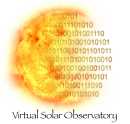| | 1 | == Observing Time == |
| | 2 | |
| | 3 | Observing time is by general consensus the most likely parameter to be |
| | 4 | used as a first case for searches, the most ubiquitous indexing parameter |
| | 5 | for data, and one on which there is widespread agreement and understanding |
| | 6 | of representations, scales, and units. Most of the complexity involved |
| | 7 | is in the descriptions of data translation. Here it is sufficient to |
| | 8 | specify a simple uniform description. |
| | 9 | |
| | 10 | |
| | 11 | (Most observational data are expected to be associated with observing |
| | 12 | times, and so far all VSO query structures have been assumed to include |
| | 13 | a time search parameter. It is possible however that some data may not |
| | 14 | be; model data are an example. As described above, such data would |
| | 15 | automatically satisfy any time interval query, and at least one additional |
| | 16 | parameter would be required to make them selectable.) |
| | 17 | |
| | 18 | ==== Observation_Time ==== |
| | 19 | type: ''time''[[BR]] |
| | 20 | FITS keyword: ''T_OBS'' |
| | 21 | |
| | 22 | The time at which the data comprising an atomic data set were originally |
| | 23 | recorded. If the duration of the data in the atomic data unit is large |
| | 24 | compared with the search time resolution, the Observation_Time is to be |
| | 25 | understood to correspond to the ''center'' (mid-point) of the observation(s), |
| | 26 | weighted as appropriate. For purposes of the Data Model, Observation_Time |
| | 27 | is given in calendar-clock form, ''e.g.''2004.03.08_16:25. Times are |
| | 28 | assumed to be UTC. The time resolution is one minute, so for much data |
| | 29 | the conversion from say start time of an exposure to Observing_Time should |
| | 30 | not matter. Likewise the conversions between UTC and other units such as |
| | 31 | ET, TAI, and GPS should not be a matter of much concern. A data match is |
| | 32 | assumed to include all data from 30 seconds before the target time to 30 |
| | 33 | seconds after, inclusive (closed at both ends), so that a data Observation_Time |
| | 34 | can in principle fall into two adjacent target times. Note that since Jan 1, |
| | 35 | 1999, TAI = UTC + 32 sec, and GPS = UTC + 13 sec. |
| | 36 | |
| | 37 | ==== Duration ==== |
| | 38 | |
| | 39 | type: ''number''[[BR]] |
| | 40 | unit: ''second''[[BR]] |
| | 41 | FITS keyword: ''T_LENGTH'' |
| | 42 | |
| | 43 | The interval between the start and end of observation in the atomic |
| | 44 | data unit. For a single image or spectrum, this is simply the exposure |
| | 45 | time; for a movie, it is the time difference between the start of the |
| | 46 | first image and the end of the last. |
| | 47 | |
| | 48 | ==== Time_Step ==== |
| | 49 | type: ''number''[[BR]] |
| | 50 | unit: ''second''[[BR]] |
| | 51 | FITS keyword: ''T_STEP'' |
| | 52 | |
| | 53 | The interval between succesive time samples (data records) in a dataset. |
